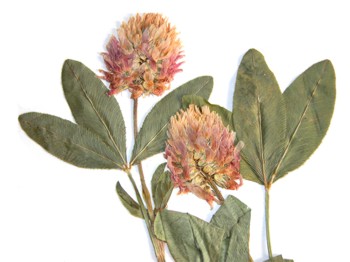Relatives
Trifolium ambiguum Bieb. - Caucasian clover, kura clover, pellett clover, honey clover.
Taxonomic position.
Family Leguminosae Endl., sect. Lotoideae (L.) D.E. Combe.Synonyms.
Trifolium vailantii Bieb., Trifolium ruprechtii Tamamsch.Biology and morphology.
It is a perennial herb. It is tap-rooted with numerous lateral roots, spreading via rhizomes. Stems are prostrate to erect, 0.5 m, branching from plant crown. Leaves are trifoliate, glabrous; leaflets are 1-3.5 cm long, lanceolate to ovate with saw-toothed margins, glaucous undersides and commonly with white V-shaped markings; petioles glabrous or slightly pubescent; membranous stipules with distinct veins. Mellifluous inflorescences 2-4 cm long, 1-2 cm broad are terminal and capitate with up to 175 white florets, changing their color to pinkish-red in the end of blossom. Standard are ovate or elliptical and much longer than the wings and keel. Obovoid flattened seed pods usually contain two light brown to brown seeds. Self-incompatible, cross-pollinated mainly by honey bees. Has diploid (2n=16), tetraploid (2n=32) and hexaploid (2n=48) forms.Distribution.
This species grows in the south of Moldavia and Ukraine, south-west of Russia, Crimea and Caucasus.Ecology.
Tree slopes, margins of forest, banks and stream banks. It is adapted to a range of soil and climatic conditions from ill-drained lowlands to alpine-type meadows at 3500 m above sea level.Utilization and economic value.
High nutritive value particularly on account of a high leaf: stem ratio. Has higher digestibility than forage legumes such as lucerne, red clover and birdsfoot trefoil. Forage protein-rich. Rhizomatous growth habit and large root mass make it resistant to heat, drought and winter cold. Persistent despite grazing once fully established, but has a slow establishment phase. It is resistant to pests and diseases. Forage highly acceptable to livestock and of high feeding value. It is an excellent plant for honey production. There is a risk of bloating for livestock. Poor seed producer.Reference citations:
Brezhnev D.D., Korovina O.N. 1980. Wild relatives of the cultivated plants of flora of the USSR. Leningrad: Kolos. 376 pp. (In Russian)Galushko, A.I. 1980. Flora of Northern Caucasus. A field guide. V. 2. Rostov-na- Donu. 350 pp. (In Russian)
Grossheim, A.A. 1952. Genus Trifolium. Flora of the Caucasus. V. 5. Moscow-Leningrad: AN USSR. 191-221 p. (In Russian)
Kolakovskiy, A.L. 1958. Flora of Abhasiya. V. 3. Tbilisi. 292 pp. (In Russian)
Mosel H. 1965. Comparative Chorology of the Flora of Central Europe. Jena. 583 p.
Mukhina, N.A. & A.K. Stankevich, ed. 1993. Flora of cultivated plants. V. XIII. Trifolium, Lotus. Moscow: Kolos. 334 pp. (In Russin)
Phyodorov, A.A., ed. 1987. Flora of the European part of the USSR. V. VI. 254 pp. (In Russian)
Shishkin, V.K. & E.G. Bobrov, ed. 1945. Flora of the USSR. V. 11. Moscow-Leningrad: AN USSR. 129-176 p. (In Russian)


